Edgar Degas (1834-1917) was a prominent French artist associated with the Impressionist movement, though he often identified more closely with Realism. He is celebrated for his innovative use of perspective, unusual compositions, and ability to capture movement and emotion, especially in his depictions of dancers, horse races, and everyday Parisian life. Degas’s work remains notable for its mastery of line, form, and his pioneering use of mixed media.
Early Life and Background
Born on July 19, 1834, in Paris, Degas came from a wealthy family with Italian and Creole roots. His father, Augustin De Gas (later spelled “Degas”), was a banker who supported Edgar’s early artistic ambitions. Degas was initially expected to pursue a career in law, and he briefly studied at the University of Paris. However, in 1855, he enrolled in the École des Beaux-Arts (School of Fine Arts) in Paris, studying under Louis Lamothe, a student of Ingres. Ingres himself was an important influence on Degas, instilling in him a respect for classical drawing techniques and an emphasis on line, which would become foundational to his style.
Influences and Artistic Development
In the 1850s, Degas traveled to Italy, where he spent several years studying Renaissance art. The influence of Italian masters like Raphael and Michelangelo can be seen in his early works, which focused on history and portraiture, in line with traditional academic subjects.
As he returned to Paris in the 1860s, Degas’s style began to evolve. He moved away from historical and mythological scenes, turning his focus to scenes of contemporary life, which was a hallmark of the Realist movement. He became interested in capturing the lives of ordinary people, particularly in urban settings, and started experimenting with unconventional compositions inspired by Japanese prints and photography. This experimentation would become key to his development as an artist.
Relationship with Impressionism
Though Degas is often grouped with the Impressionists, he differed from many of them in his approach. While Impressionists like Monet and Renoir were interested in plein air (outdoor) painting and the effects of light, Degas preferred to work indoors, often from memory or sketches, focusing on line, form, and structure. He shared the Impressionists' interest in capturing modern life and the transient effects of movement but remained more focused on accuracy and control in his compositions.
Degas participated in several Impressionist exhibitions and was considered a core member of the group. However, he often distanced himself from the term “Impressionist,” as he valued clarity and drawing over the looser brushwork commonly associated with the movement. Instead, he preferred to describe himself as a Realist or Independent.
Artistic Style and Themes
Degas’s work is distinguished by its unique blend of Realism and Impressionism, and he explored many recurring themes, including:
Dance and Ballet
Degas is perhaps best known for his paintings, drawings, and sculptures of ballet dancers, which make up over half of his body of work. These pieces capture both the grace and physical strain of dance, often portraying dancers in rehearsal, where their movements are less idealized. His ballet works frequently feature unusual angles, cropped compositions, and a strong sense of movement.Everyday Life and the Female Form
In addition to dancers, Degas often depicted women engaged in everyday activities, such as bathing, dressing, or working. His nudes and domestic scenes are celebrated for their naturalism and realism, showing women in private, unidealized moments. This exploration of ordinary life was groundbreaking at a time when nudes were typically portrayed in mythological or classical contexts.Horse Racing and Jockeys
Another favorite subject of Degas’s was horse racing, which he admired for its dynamic movement and drama. He painted and sketched horses and jockeys in a range of scenes, from pre-race preparations to moments of intense action on the track.Unusual Perspectives and Compositions
Degas was fascinated by Japanese prints, photography, and the use of unconventional perspectives. His compositions often feature cropped figures and unique angles, drawing viewers into intimate spaces and unexpected views. This experimentation had a significant influence on modern art.
Major Works
The Dance Class (1874)
This iconic painting portrays a ballet class in a rehearsal studio. The dancers are captured in various poses, with some resting or adjusting their attire, showing the mix of grace and fatigue in the life of a dancer. The composition, featuring a diagonal perspective and natural light, emphasizes the realistic, informal nature of the scene.L’Absinthe (1876)
This somber painting depicts two individuals in a Paris café, gazing distantly into their drinks. The melancholic expression of the woman and the stark interior reflect the sense of isolation and disillusionment in urban life. The unconventional use of space and distance between the figures adds to the feeling of emotional detachment.Little Dancer of Fourteen Years (Sculpture, 1881)
Degas’s most famous sculpture, this piece portrays a young ballet dancer in a naturalistic pose. He used real fabrics and a wig for the dancer’s costume, which was revolutionary in the realm of sculpture at the time. The piece was initially controversial, as its realism and unidealized portrayal of a young girl went against the classical norms of beauty.Woman in the Bath (1886)
Part of a series of women bathing and dressing, this pastel work shows a woman in a naturalistic pose, highlighting her form in a way that is both intimate and realistic. Degas's delicate use of pastel colors and loose lines captures the softness of the scene, focusing on the natural, everyday aspects of the female form.The Bellelli Family (1858-1867)
An early masterpiece, this portrait shows Degas’s aunt, uncle, and cousins in a somber domestic setting. The painting is notable for its psychological depth, depicting the tensions within the family. This work foreshadowed Degas’s later focus on character studies and psychological realism.Racehorses at Longchamp (1873-1875)
This painting captures the excitement of horse racing, with jockeys mounted and ready. The oblique angle and the horse’s movement create a sense of dynamism and tension, showcasing Degas’s fascination with the motion and energy of sports.Dancers Practicing at the Barre (1877)
This painting shows two ballet dancers practicing at a barre, one stretching and the other adjusting her posture. Degas’s use of perspective and lighting emphasizes the physical strain of dance, showing his commitment to portraying both the beauty and labor involved.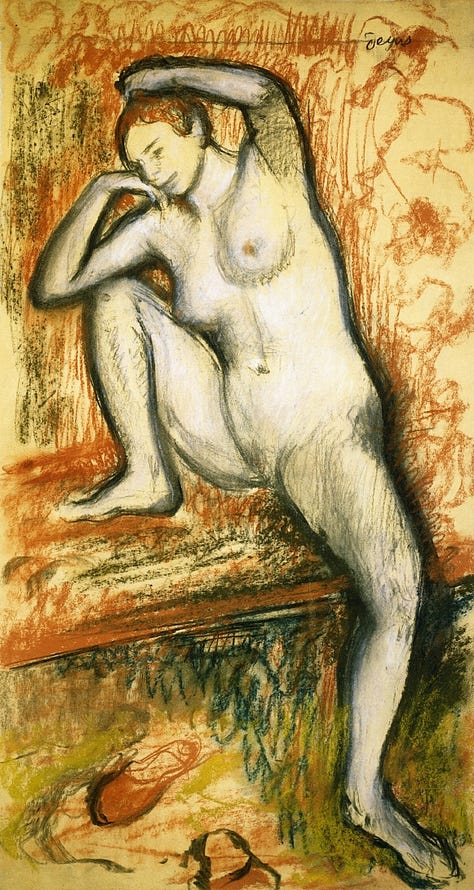
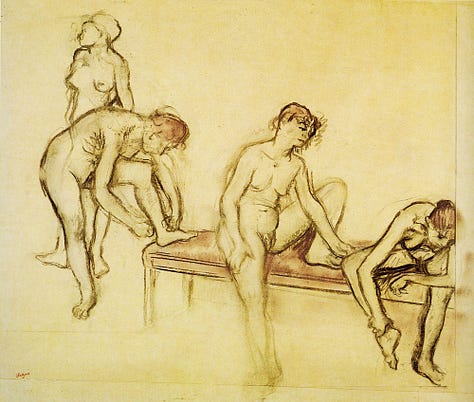
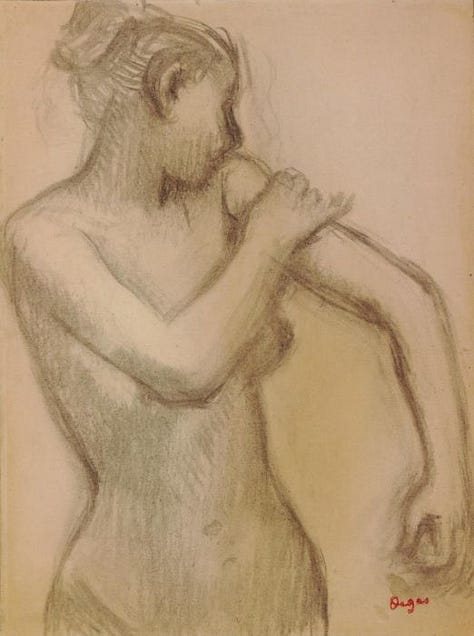
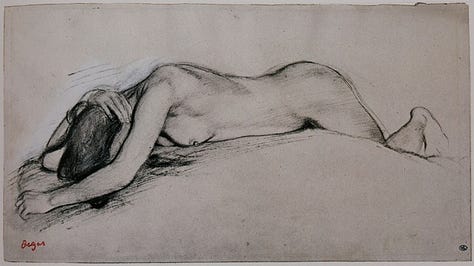
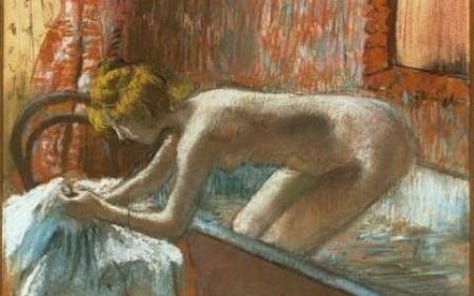

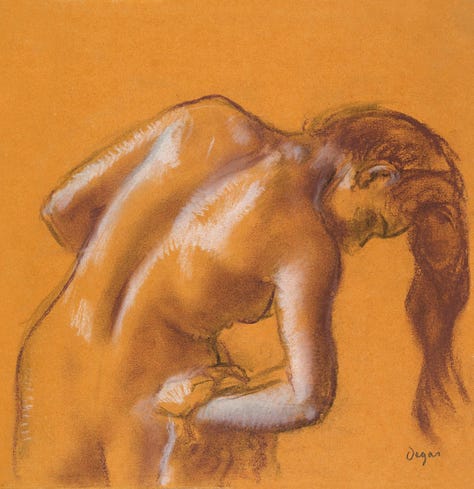


Later Life and Legacy
In his later years, Degas became increasingly reclusive. He suffered from deteriorating eyesight, which forced him to turn more to sculpture and pastels, as these media allowed him to work more freely without fine detail. Despite his visual limitations, Degas continued to experiment, producing some of his most striking works in the final years of his life.
Degas passed away on September 27, 1917, in Paris at the age of 83. He left behind an extensive body of work that continued to influence generations of artists, particularly in the areas of modernist and post-impressionist art.

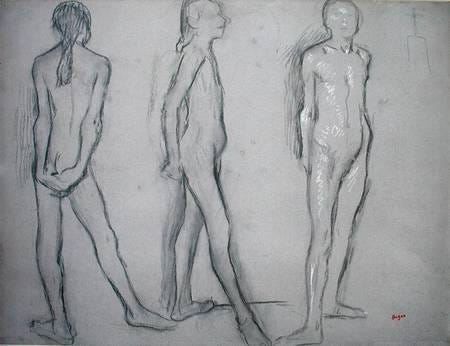
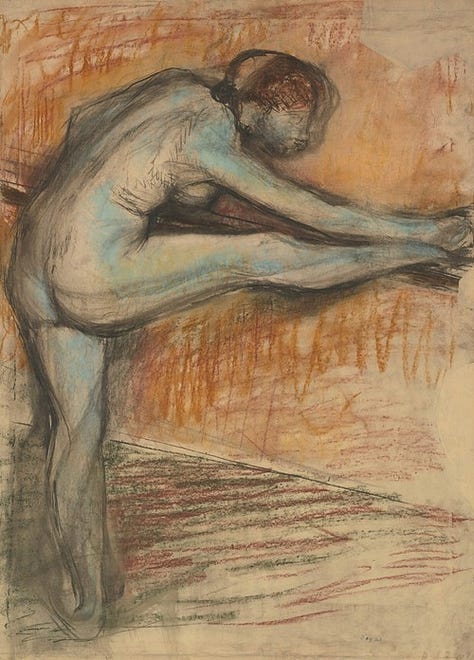
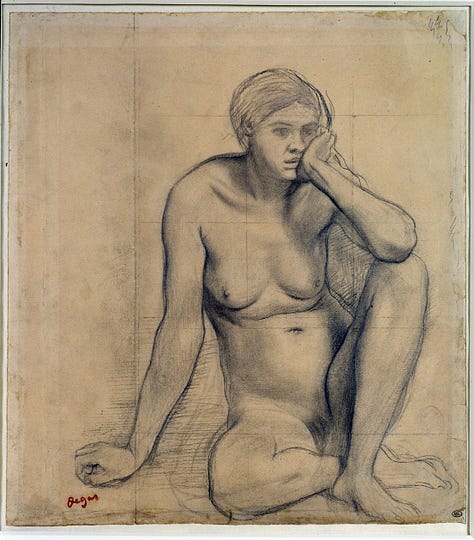
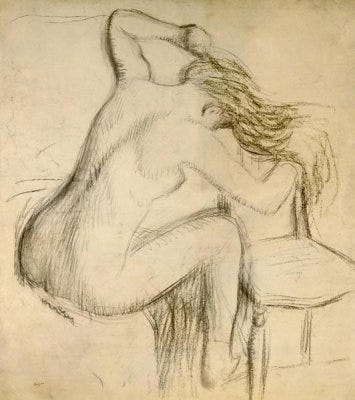
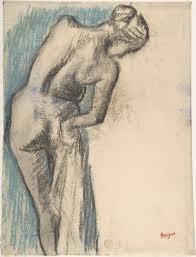

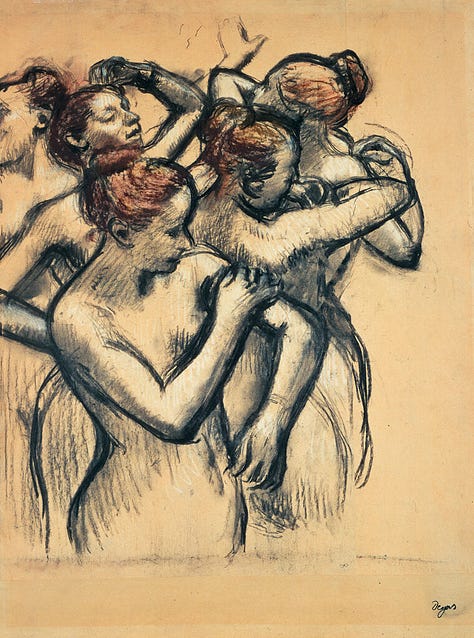

Legacy and Influence
Degas’s work has had a profound impact on modern art, influencing artists like Picasso, Matisse, and Toulouse-Lautrec, who were inspired by his innovative use of perspective, exploration of the human body, and naturalism. His focus on movement and everyday subjects opened up new avenues for realism in art and set the stage for further experimentation in the 20th century. Degas remains celebrated for his technical skill, originality, and his unflinching portrayal of the beauty and complexity of human life.
You can book us for your drawing class or attend our weekly sketching practice by visiting us at our website.
You can support us in these ways too!
1. Subscribing monthly via Substack
2. Making a one-off contribution via BuyMeACoffee
Your support is what allows these articles to keep being created and is enormously appreciated. Thank you.



